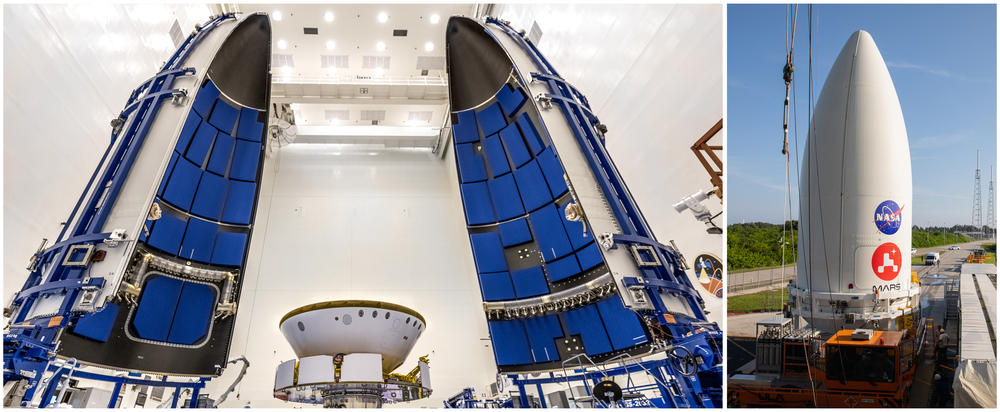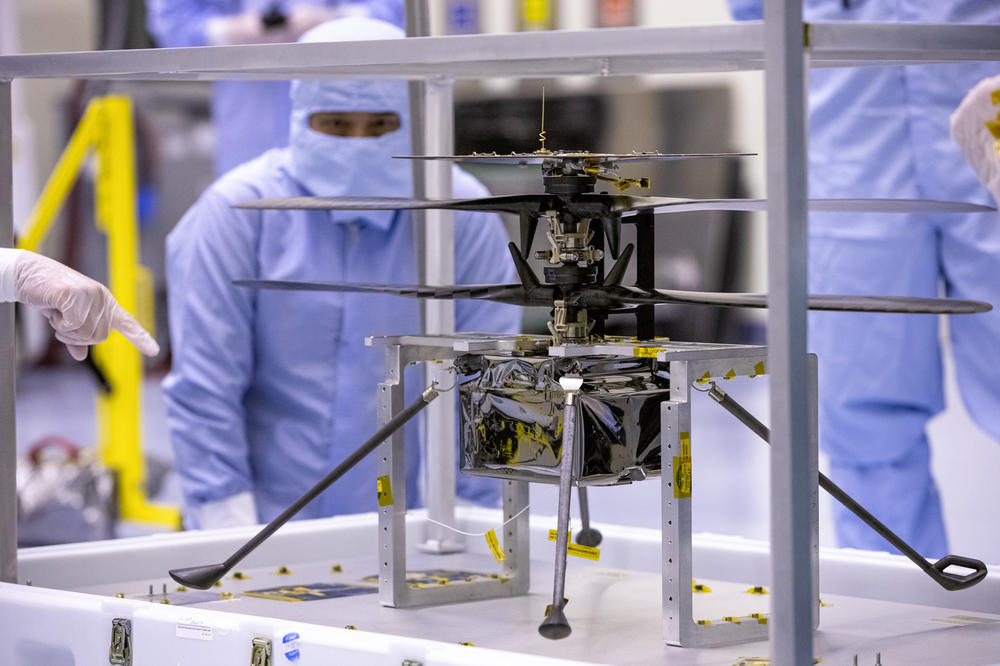Section Branding
Header Content
It's A Good Time To Head To Mars
Primary Content
If you're planning a trip to Mars, now is the time to go.
For a month or so, Earth and Mars line up in a way that makes it possible to go from one to the other. Miss that window, and you have to wait two years for the next opportunity. The United Arab Emirates, China and the United States all have missions scheduled for launch in July.
NASA's entry is a six-wheeled rover called Perseverance. It's aiming for Jezero crater, a spot on Mars that scientists think was once a lake where microbes could have lived. Landing is set for Feb. 18, 2021.
Kathryn Stack Morgan is the mission's deputy project scientist. Other rover missions have seen signals of carbon that could have been left behind by microbial life, but, she says, "We haven't been able to necessarily link the presence of that carbon to a particular pattern of texture that we see in the rock that we think could have been left behind by life."
Even if Perseverance detects carbon and sees a pattern in a rock that could have been left behind by life, the claim that there was once life on Mars would be extraordinary, and extraordinary claims require extraordinary proof.
"Very likely, we'll have to return those samples to Earth to make that definitive conclusion about whether these samples contain life in them," Morgan says.
Happily, that's just what Perseverance is designed to do. It won't actually bring back the samples, but it will collect rock samples, put them in containers and seal the containers so a future mission can bring them back to Earth.
"Our sampling system was particularly challenging in that we also had to keep it very, very clean," says Matthew Wallace, the rover's deputy project manager. "The reason we needed to do that is the science community is looking for trace signatures from billions of years ago. Trace chemical signatures. We don't want to confuse the search for those ancient signs of life [with material] we took with us to Mars and brought back."
It's going to be a while before the samples get back to Earth. If all goes well, it will happen in 2031.
At a recent news conference, NASA Administrator Jim Bridenstine said finding signs of life on Mars would be something, "but I'll tell you the thing that has me most excited as the NASA administrator is getting ready to watch a helicopter fly on another world," he said.
Perseverance is carrying a small camera-equipped helicopter that could be useful for exploring the landing site and finding interesting features for the rover to visit. It was a late addition to the mission, and while it makes the administrator's eyes light up, mission managers like Wallace seem to be trying to lower expectations.
"We are not looking for an extensive and ambitious return from this technology," Wallace says. "We're trying to learn those first few things we need to learn."
So probably no dramatic tracking shots like in the movies.
The United Arab Emirates has several reasons for its Mars mission, whose Hope probe will reach Mars in 2021.
"The UAE was established on Dec. 2, 1971,"says Sarah Al Amiri, deputy project manager and science lead for the Emirates Mars Mission. That makes 2021 the country's 50th birthday, so the Emirati leadership was eager to do something to celebrate.
"The purpose was not only to get to Mars by 2021 and have valid scientific data coming out of the mission that is unique in nature and no other mission has captured before," Al Amiri says. "But more importantly, it was about developing the capabilities and capacity of engineers in the country."
Al Amiri says that the Emirati leadership has been pushing the country to develop a more knowledge-based economy and that building a Mars probe provided a focus for expanding the country's technological capabilities.
Omran Sharaf is project director for the Mars mission. He says the UAE's engineers were building on technology that other countries had employed successfully to explore the solar system.
"The government want us to be smart about it," Sharaf says. "They said don't start from scratch — start where others ended."
The Emirates Mars Mission's craft weighs around a ton and a half and is about the size of a small car. "When you have the solar panels deployed, it's going to be about 8 meters in width and about 3 meters in height," he says.
When it gets to Mars, it will go into an unusual orbit that will take it over essentially every point on Mars once a week. Science lead Al Amiri says that will give it a valuable perspective of the whole planet over time.
"It's providing us with full understanding of the changes of the weather of Mars throughout an entire Martian day and throughout all the seasons of Mars throughout an entire Martian year, which lasts roughly two Earth years," she says.
Collaborating on the mission is a team of scientists at the University of Colorado in Boulder. David Brain is the core science team lead.
He says the probe does fulfill the goal of collecting data about Mars that no other spacecraft has provided.
"The three instruments that are on the spacecraft will help us measure the atmosphere of Mars from the surface all the way to space, which hasn't really been done before with other missions," Brain says.
Details about China's Mars mission are scarce. It consists of an orbiter and a lander. The lander carries a rover that reportedly has ground-penetrating radar that can look for evidence of underground water.
The mission does have a name: Tianwen-1. According to the Xinhua News Agency, the name comes from a poem by that name meaning "heavenly questions" that was written more than 2,000 years ago by the poet Qu Yuan.
Copyright 2020 NPR. To see more, visit https://www.npr.org.






